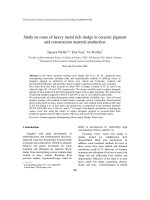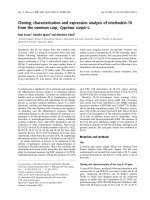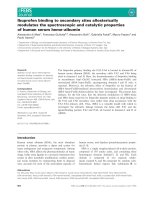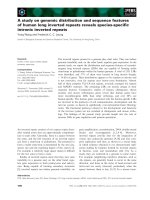Báo cáo " Study on the characteristics and catalytic properties of Pt/SBA-15 in the selective oxidation of D-Glucose " potx
Bạn đang xem bản rút gọn của tài liệu. Xem và tải ngay bản đầy đủ của tài liệu tại đây (819.59 KB, 8 trang )
VNU Journal of Science, Natural Sciences and Technology 26 (2010) 183-190
183
Study on the characteristics and catalytic properties of
Pt/SBA-15 in the selective oxidation of D-Glucose
Tran Thi Nhu Mai*, Nguyen Thi Minh Thu, Pham Dinh Trong,
Nguyen Thi Ha, Giang Thi Phuong Ly
Faculty of Chemistry, Hanoi University of Science, VNU, 334 Nguyen Trai, Hanoi, Vietnam
Received 5 May 2010
Abstract. In this work, platinum nanoparticles were dispersed on SBA-15 mesoporous material by
incipient wetness method and the synthesized materials were characterized by XRD, TEM, EDX
spectroscopies and N
2
adsorption-desorption isotherm measurement.
The results indicated that 2D hexagonal ordered structure of SBA-15 was still maintained
after grafting Pt on SBA-15 support and platinum nanoparticles existed both inside and outside the
pore channels of SBA-15 material. Catalytic activity of these materials was tested in the aqueous
phase D-glucose oxidation as a model reaction. The reaction was carried out in a glass reactor at
atmospheric pressure, 80
o
C, air flow rate 20ml/minute, at pH 9. The results from HPLC-RID
method showed that the pH has a profound effect in the platinum-catalyzed oxidation of glucose
and high conversion of D-glucose with the highest selectivity to D-gluconic acid was performed
with 1%Pt/SBA-15 catalyst.
1. Introduction
∗
∗∗
∗
Gluconic acid and its salts are important
industrial products, they are used as water-
soluble cleansing agents or additives in foods
and beverages. For commerical purposes, these
products are exlusively prepared by the
oxidation of glucose or glucose-containing raw
materials. Althrough the currently used
oxidation method is based on biochemical
tranformation but recent development has
indicated that the catalytic route may be valid
alternative for producing gluconate on an
_______
∗
Corresponding author. Tel.: 84-4-38261857.
E-mail:
industrial scale. For this reason, many
interested reseachs in order to discover the
active catalyst for this process have been taken
out. In this paper, Pt/SBA-15 materials with
various Pt loading on high surface area
siliceous support were prepared and tested in D-
glucose oxidation process. The properties of
these materials were characterized by XRD,
TEM, EDX, and N
2
adsorption-desorption
methods and the products of the oxidation
reaction were determined to estimate the effect
of Pt contents, pH and catalysts’ nature on the
reaction conversion and gluconic acid
selectivity.
T.T.N. Mai et al. / VNU Journal of Science, Natural Sciences and Technology 26 (2010) 183-190
184
2. Experimental
2.1. Catalyst preparation
Synthesis of SBA-15: 1g of Pluronic P123
triblock copolymer (E020P070E020, BASE
U.S.) as structure-directing agent was dissolved
in 75 ml of 1.5 M HCl , and then 2.1g of
tetraethylortho-silicate (TEOS) as silicon
source was added under strong magnetic
stirring at 50°C for a day. The solution was
aged for another day at room temperature. After
filtration, washing with distilled water and
drying at 100
o
C, the sample was calcined at
550°C in ambient air for 5h and the white
SBA- 15 was obtained.
Synthesis of Pt/SBA-15: Platinum was
supported on SBA-15 mesoporous material by
incipient wetness method using calculated
content of H
2
PtCl
6
5.10
-3
M. The heterogeneous
mixture was refluxed at 75
0
C for 3 hours and
continuously stirred. NaBH
4
solution in ethanol
was dropped slowly to reduce all plantinum salt
to the metallic state. The suspension was
filtered, washed several times with distilled
water, dried at room temperature overnight and
then at 90
0
C in 5 hours and the light yellow
sample of Pt/SBA- 15 was obtained.
Platinum was supported on SBA-15 with Pt
various contents (% wt): 1% Pt/ SBA -15
(signed PS -1), 2% Pt/ SBA -15 (signed PS -2),
3% Pt/ SBA -15 (signed PS -3)
2.2. Instrumentation
X-ray Diffraction (XRD) spectroscopy was
performed on a SIEMENS D5005 spectrometer
(CuKα, wavelength λ= 1,540 Å, voltage 40kV,
current 30mA, at room temperature with a scan
speed of 0.2
o
/minute in a 2θ range of 0-40
o
.
High resolution transmission electron
microscopy (HR-TEM) was carried out on
JEOL-JEM 1010 instrument with voltage
80,0kV and on HITACHI H-7100 Electron
microscope with voltage 100,0kV, Direct Mag:
600000x(Japan Advanced Institute of
Science and Technology). N
2
adsorption-
desorption method and Energy Dispersive X-
ray Spectroscopy (EDX) were measured on
Micromerictics ASAP 2010 and Varian Vista
Ax apparatuses, respectively.
2.3. Oxidation procedure of D-Glucose
The reaction was carried out in liquid phase
with the presence of oxygen in air, at the range
of temperature 50-90
0
C. The pH value was
maintained at 9 and air flow was controlled by
Flow Meter 110 AC device. The products of the
oxidation was determined by High performance
liquid chromatography method (HPLC) with
refractive index detection (RID).
3. Results and discussion
3.1. Characteristics of SBA-15 material
The low-angle XRD patterns of SBA-15
at different aging time (24, 48 and 72 hours) as
showed in Fig.1 are similar and all show a
prominent peak at 2θ=0.9-1
o
and two weak
peaks around 2θ=1.5-2
o
, which could be
indexed as (100), (110), and (200) planes. This
is the characteristic hexagonal mesoporous
structure of the SBA-15 matrix associated with
P6mm symmetry group [3]. The increase of
aging time from 24 to 72h leaded to the
increase of d-spacing between the planes (100)
from 88.62 Ǻ (24h) to 93.87Ǻ (48h) and
97.43Ǻ (72h). In these XRD patterns, we also
see that two weak peaks indexed as (110) and
(200) diffractions of 24h sample are not clear
and the intensity of these peaks increases in
accordance with aging time, this means that the
order of SBA-15 is not enough high at shorter
time treatment.
T.T.N. Mai et al. / VNU Journal of Science, Natural Sciences and Technology 26 (2010) 183-190
185
Figure 1. Low-angle XRD patterns of SBA-15 at different aging time (24, 48 and 72 hours).
3.2. Characteristics of Pt/SBA-15 materials
a. X-ray powder diffraction
XRD patterns (Fig.2) of PS-1, PS-2 và PS-
3 samples display three peaks of (100), (110),
and (200) diffractions in agreement with 2θ
angles ~ 0.9
0
, 1.7
o
, 1.9
o
, respectively. All peaks
are very obvious which indicate that the
modified materials have high order structures and
the introduction of Pt did not affect the hexagonal
structure of SBA-15 support material [3].
Figure 2. X-ray diffraction patterns of PS-1, PS-2 and PS-3 samples.
PS-1
PS-
2
PS-3
T.T.N. Mai et al. / VNU Journal of Science, Natural Sciences and Technology 26 (2010) 183-190
186
The typical peaks of Pt crystal appear in
XRD pattern at 2θ=30
o
-40
o
[4,5], but in this
research, we did not see any peaks at that range
angle. This is because of the low Pt content
(<5%) and maybe Pt was well dispersed in the
pore of SBA-15 mesoporous material.
b. High resolution transmission electron microscopy
The high resolution TEM images
(Fig 3a,
b)
were recorded along two different
crystallographic directions, both of which show
the typical features of SBA-15 with the well-
ordered hexagonal arrays of mesopores and
straight lattice fringes from the images viewed
along and perpendicular to the pore axis,
confirming the existence of a 2-D hexagonal
structure of a p6mm symmetry. The distance
between two pore centres is about 6nm and the
high wall thickness (6-7nm) is beneficial to
thermal and hydrothermal stabilities of SBA-15
synthesized material.
HRTEM images of Pt/SBA-15 (Fig 3c, d, e)
provide direct observation of regular channel
structure and distribution of Pt nanoparticles in
SBA-15. The TEM images show that all
samples prepared by incipient wetness
method kept 2D hexagonal ordered
mesoporous structure of SBA- 15, which is
in agreement with the results of XRD. With
the electron beam parallel to the pore channels
(Fig. 3c-PS-1 sample), no obvious bulk
aggregates of the plantinum metal species on
the outer surface could be found. This result
was further confirmed by HITACHI H-7100
Devices with the higher
voltage 100,0kV and higher magnification
0f 600.000x(Fig 4). This proved that Pt was
dispersed with nano sizes (<6nm) inside the
pore of SBA-15 mesoporous material. At this
size, Pt shows high performance for many
chemical conversions [4-6].
(a) (b)
(c) (d) (e)
Figure 3. Transmission electron micrographs of SBA-15 in the direction of pore axis (a)(100) and in the
direction perpendicular to the pore axis SBA-15 (b) (110); PS-1 (c); PS-2 (d) and PS-3 (e).
T.T.N. Mai et al. / VNU Journal of Science, Natural Sciences and Technology 26 (2010) 183-190
187
TEM image of PS-2 along the mesopore
channels in Fig. 3d appears some black spots
which are likely to originate from bigger
platinum particles or clusters of ultra-small
plantinum nanoparticles. The black areas
corresponding to the larger clusters of
platinum with the size measured on HRTEM
micrograph at range of 12-15 nm (Fig. 3e)
were dispersed outside the channels of SBA-15
mesoporous material when the content of
platinum increase to 3% in weight.
Figure 4. Transmission electron micrographs of
Pt/SBA-15(PS-1) in the direction of pore axis (a)
(100), HV= 100 kV, Direct Mag: 600.000x
c. Energy Dispersive X-ray Spectroscopy
The content of Pt was determined again by
EDX method after reducing platinum salt with
NaBH4. Figure 5 of PS-1 (1% Pt/ SBA-15)
sample displays typical peaks of Si and Pt and
the result from the quantitative estimation of
peak areas gives 0,98% weight content of
platinum. This means that most of platinum was
reduced and maintained on SBA-15 support
material.
Figure 5. EDX diagram of PS-1.
d. N
2
adsorption-desorption method
All N
2
adsorption-desorption isotherms are
type IV with a H1 hysteresis loops according to
IUPAC classification, indicating that there exist
mesopore in all samples with cylindrical pore
structure. The BJH pore size distribution curves
are very sharp indicating the very regular pore
diameter of these materials. Capilary
condensation of SBA-15 begins at P/P
o
=0.6
higher than 1%Pt/SBA-15 (P/P
o
=0.5) and the
wide of hysteresis loop of SBA-15 larger than
PS-1 show that after supporting plantinum on
SBA-15 material, the pore size of this
denatured material decreases.
T.T.N. Mai et al. / VNU Journal of Science, Natural Sciences and Technology 26 (2010) 183-190
188
(a)
(b)
Figure 6. Nitrogen adsorption isotherms measured at
-196
o
C and the corresponding BJH pore size
distribution of SBA-15 (a) and 1% Pt/SBA-15 (b)
samples.
All parameters about surface area, pore
diameter, pore volume, of these materials are
showed in table 1:
Table 1. Physical parameters of SBA-15
and PS-1 mateials
Samples S
BET
(m
2
/g)
V
t
(cm
3
/g) D
p
(nm)
SBA-15 727 1,08 6,77
1%Pt/SBA-15
342 0,49 5,83
The results in table one show the average
pore diameter, pore volume and BET surface
area decrease obviously with an incorporation
of Pt into SBA-15 material and this proves that
platinum with very small nano sizes was
dispersed inside the pore of support material.
3.3. Catalytic activities of Pt/SBA-15 in the
oxidation of D-glucose
The results of the oxidation of D-glucose
carried out on Pt/SBA-15 catalyst were
presented in table 2:
Table 2. The results of the oxidation of D-glucose over different catalysts
(Temperature: 80
0
C; Air flow rate: 20ml/min; Time: 2 hours)
Composition of products (%) Catalysts Conversion of
glucose (%)
Gluconic acid Lactone Disaccharide Other
products
HNO
3
87,67 15.80 15,69 12,60 57,01
PS-1 (pH~9) 74,54 86,63 3,16 8.20 2,01
PS-2 (pH~9) 70,14 85,81 3,64 8,57 1,98
PS-3 (pH~9) 48,87 86,56 3,25 8,11 2,08
PS-1 (pH
*
) 51,72 53,04 22,73 22,42 1,81
- Other products: Tartaric, threonic, acrylic acids, and the products of decarboxylation
- pH
*
: The oxidation reaction was performed without pH control
T.T.N. Mai et al. / VNU Journal of Science, Natural Sciences and Technology 26 (2010) 183-190
189
- From the results above, we found that both
HNO
3
and Pt/SBA-15 present a good
conversion in the oxidation reaction of glucose.
The conversion of the reaction reached 87.67%
when using HNO
3
as oxidizing agent, but the
selectivity of D-gluconic product is quite low.
The high oxidation ability with high acidity of
HNO
3
make the reaction occur at many
positions and in different ways, so by-products
occupy at very high level (~84%).
Figure 7. HPLC-RID image of the products of
D-glucose oxidation on PS-1 catalyst
On the other hand, the reaction on Pt/SBA-
15 catalysts with pH control not only showed a
high conversion, but also high D-gluconic acid
selectivity. This determined a good suitability
of plantinum nanoparticles in the selective
oxidation of glucose. When the reaction was
performed without pH control on PS-1 catalyst,
the conversion decreased significantly. The pH
at the end of the reaction was about 2.7. This
condition facilitated the formation of
gluconolactone and disaccharide and inhibited
the catalyst activity [2]. So, we should add
alkaline solution continuously to maintain pH
value at 9 during the oxidation process. In table
2, we also see that increasing the Pt contents led
to decrease in catalytic activity. The average
particle size of the catalyst with the lower
platinum content (1%) is smaller (<6nm) than
that of the catalyst with 2 and 3% Pt contents,
which has an average particle size of 10-15 nm
(TEM images) explained for this difference. On
the other hand, Pt nanoparticles existed inside
the pore channels of SBA-15 (PS-1), active
sites are located in confined spaces, so the
collision rate of these sites with glucose
molecules increase and catalytic activity of
nanoparticles inside will be better than large
clusters outside the pore channels of support
material.
4. Conclusions
In conclusion, SBA-15 was successfully
prepared by hydrothermal synthesis using
Pluronic P123 as template and TEOS as silica
source. The synthesized material has high
specific surface area, narrow pore size
distribulation, and large pore with high wall
thickness which is very suitable for using as
support material. Platinum was dispersed
effectively on SBA-15 by incipient wetness
method and still kept the original 2D hexagonal
mesostructure. When Pt loading is about 1% by
mass, Pt nanoparticles were highly dispersed
with the size under 6nm in the channels of
SBA-15 and at this state, Pt/SBA-15 catalyst
showed the highest activity and selectivity in
the oxidation of glucose. When increasing the
content of Pt loading, most Pt nanoparticles
aggregated outside the channels of SBA-15
with size of 10-15nm and catalytic activities of
these materials decreased. pH value also affects
directly on the selectivity of gluconic acid
product and the best condition for the reaction
is pH 9.
Acknowledgement
This work was financially supported by
the QG-09-08 project of Vietnam National
T.T.N. Mai et al. / VNU Journal of Science, Natural Sciences and Technology 26 (2010) 183-190
190
University, Hanoi. The work was further
facilitated by the VNU-JAIST project, Ebitani's
lab for TEM image(HITACHI H-7100)
References
[1] Ayumu Onda, Takafumi Ochi, Koji Kajiyoshi. A
new chemical process for catalytic conversion of
D-glucose in to lactic acid and gluconic acid.
Applied catalysis A: general 343 (2008), p 49-54
[2] A.Abbadi, H.Van bekkum., “Effect of pH in the
Pt catalyzed oxidation of D-glucose to D-
gluconic acid”. Molecular catalysis A: chemical,
97, p111-118
[3] Karuna Chaudhari, Synthesis, characterization
and catalytic properties of mesoporous
molecular sieves, A thesis for the degree of
doctor of philosophy in Chemistry, May 2003
[4] Lorna Ortiz-Soto, Corina Mihut, Oleg Alexeep,
Michael D.Amiridis. Synthesis and
characterization of Bimetallic Pt-Au cluster-
derived catalyst. Catalysis Today, 125, 269-274,
2006.
[5] A.Corma and Hermenegilldo Garcia.
Nanoparticles and catalysis. Wiley-VCH Verlag
GmbH and Co.KgaA, Weiheim. ISBN 978-527-
31572-7
[6] Hui Meng, Pei Kang Shen. Novel Pt-free
catalyst for oxygen electroreduction.
Electrochemistry communication (2006) p588-
594.
Nghiên cứu ñặc trưng và tính chất xúc tác của vật liệu
Pt/SBA-15 trong phản ứng oxi hoá chọn lọc D-Glucozơ
Trần Thị Như Mai, Nguyễn Thị Minh Thư, Phạm Đình Trọng,
Nguyễn Thị Hà, Giang Thị Phương Ly
Khoa Hóa học, Trường Đại học Khoa học Tự nhiên, ĐHQGHN, 19 Lê Thánh Tông, Hà Nội
Trong bài báo này, Pt nano ñược phân tán lên vật liệu mao quản trung bình SBA-15 bằng phương
pháp tẩm dung dich rồi kết tủa bằng chất khử NaBH
4
Các mẫu vật liệu tổng hợp ñược ñặc trưng bằng
các phương pháp XRD, TEM, EDX, Hấp phụ và giải hấp phụ N
2
.
Vật liệu SBA-15 tổng hợp ñược có mao quản hexagonal 2D có ñộ trật tự cao. Pt ñạt kích thước
nano phân tán trong mao quản và ngoài mao quản phụ thuộc vào nồng ñộ tiền chất và ñiều kiện phân
tán. Hoạt tính xúc tác ñược ñánh giá trong phản ứng oxi hoá glucozơ. Phản ứng ñược thực hiện ở pha
lỏng, nhiệt ñộ 80oC, tốc ñộ thổ khí 20 ml/phút và ở pH 9. Xúc tác chứa Pt nano có hiệu quả tương ñối
cao cho quá trình oxi hoá chọn lọc glucozơ tạo axit gluconic.Từ kết quả phân tích sản phẩm phản ứng
bằng HPLC-RID cho thấy hàm lượng, kích thước hạt xúc tácPt ảnh hưởng ñến ñộ chuyển hoá glucozơ
trong khi pH có ảnh hưởng quyết ñịnh ñến tính chọn lọc axit gluconic và các phản ứng phụ. Xúc tác
1% Pt/SBA-15 cho ñộ chọn lọc axit gluconic cao.









